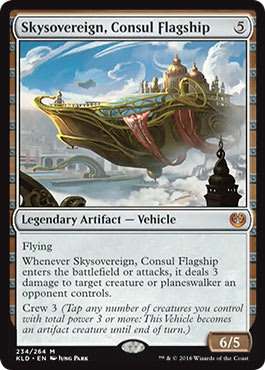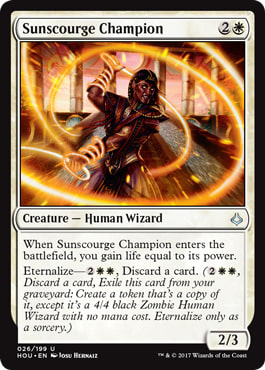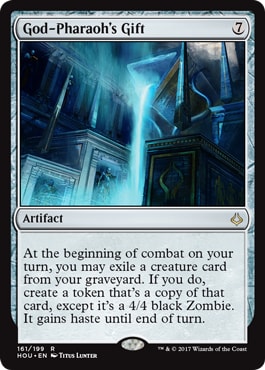Just last week, it seemed like Standard was on the precipice of unplayability due to the power and resilience of Mono-Red. How quickly things all change, in the span of a single weekend! If I were Jim Cramer I’d be throwing chairs, because few expected the rise of Sylvan Advocate and Catacomb Sifter in Standard, yet here we are. This is the beautiful era of Standard, where you can stay one step ahead of the metagame, with unique and unexpected card choices or sideboard jukes, and gain massive advantages week-in and week-out. We’ll certainly see the next evolution in Standard in the coming weeks, with GP Denver on the horizon. Where is this format now, where is it going, and how can you gain the biggest edge in the next twist of the metagame?
In Standard, we see the very beginnings of a familiar pattern. The “midrange regression”, as I like to call it, is a time-worn pattern in reasonably healthy Standard formats, and the story is as old as B/G/x midrange. It goes something like this: at the start of a Standard format, the best aggressive decks dominate. Whether Vehicles, Mono-Red, or White Weenie, the characters are fairly scripted. After a week or two, the first midrange decks start coming together to prey on the specific weaknesses of the given aggro enemies, and that’s when the fun starts. Over time, Putrid Leeches turn into Grim Discoveries and extra Mind Rots. Rakshasa Deathdealers and Fleecemane Lions turn into Read the Bones and Tasigur, the Golden Fangs. Olivia Voldarens or Wurmcoil Engines start finding their way into maindecks, Glint-Sleeve Siphoners and Longtusk Cubs turn into Sylvan Advocates and Catacomb Sifters, and the arms race begins. Slowly but surely, the natural churn of the metagame starts, where week-in and week-out people attempt to one-up each other by “going bigger”, or having a sideboard plan to position themselves as the control in the mirror match. We’ve seen it with Abzan Midrange in Siege Rhino Standard, we’ve seen it with Jund Midrange in Bonfire of the Damned Standard, and we’ll be seeing it over the next few months in Winding Constrictor Standard. In this format, of course, there are the dual pressures of Mono-Red and Zombies waiting to crush the traditional midrange decks between them, which will ameliorate the speed and effect of the regression phenomenon, but pay attention. You’ll see it yourself, the midrange decks will slow down, tune their sideboards for other midrange decks and the rising control decks, and eventually become just a tad too slow, putting themselves at the mercy of a good, honest Bomat Courier or Hazoret the Fervent.
This is the circle of life (of the metagame). Try to understand it, not to contain or reverse it. Like it or not, you too are a part of it.
How is this playing out in the current Standard metagame? Well, we’ve already seen the first volleys from Sam Pardee at the Pro Tour and Brad Nelson and Corey Baumeister at Grand Prix: Minneapolis. Catacomb Sifter is a direct shot at Mono-Red, as the ![]()
![]() answer to Whirler Virtuoso does a ton of work against cards like Earthshaker Khenra and Ahn-Crop Crasher alike. Grasp of Darkness handles angry Gods, and Sylvan Advocate turns the corner to race Ramunap Ruins quick, fast, and in a hurry. I personally prefer Sam Pardee’s Delirium-based deck, as Grim Flayer and Traverse the Ulvenwald are at least the equals of Sylvan Advocate and Oath of Nissa, but the Advocate is a huge key to winning the Red matchup, so for now this is the public enemy #1 of midrange decks.
answer to Whirler Virtuoso does a ton of work against cards like Earthshaker Khenra and Ahn-Crop Crasher alike. Grasp of Darkness handles angry Gods, and Sylvan Advocate turns the corner to race Ramunap Ruins quick, fast, and in a hurry. I personally prefer Sam Pardee’s Delirium-based deck, as Grim Flayer and Traverse the Ulvenwald are at least the equals of Sylvan Advocate and Oath of Nissa, but the Advocate is a huge key to winning the Red matchup, so for now this is the public enemy #1 of midrange decks.
B/G Midrange ? Hour of Devastation Standard | Ben Friedman
- Creatures (21)
- 2 Rishkar, Peema Renegade
- 3 Verdurous Gearhulk
- 4 Catacomb Sifter
- 4 Sylvan Advocate
- 4 Walking Ballista
- 4 Winding Constrictor
- Planeswalkers (3)
- 3 Nissa, Voice of Zendikar
- Instants] (7)
- 3 Grasp of Darkness
- 4 Fatal Push
- Enchantments (4)
- 4 Oath of Nissa
- Artifacts (1)
- 1 Aethersphere Harvester
- Lands (24)
- 7 Swamp
- 9 Forest
- 4 Blooming Marsh
- 4 Hissing Quagmire
- Sideboard (15)
- 1 Crook of Condemnation
- 1 Dispossess
- 2 Gonti, Lord of Luxury
- 2 Lost Legacy
- 2 Never // Return
- 2 Skysovereign, Consul Flagship
- 3 Transgress the Mind
- 2 Yahenni's Expertise
![]()
![]() Midrange isn’t the only midrange success story of the weekend, though. Over on MTGO, we saw Immanuel Gerschenson and Remi Fortier take Temur Energy to the top of the MOCS, with Gerschenson winning the whole thing! Why Temur Energy over
Midrange isn’t the only midrange success story of the weekend, though. Over on MTGO, we saw Immanuel Gerschenson and Remi Fortier take Temur Energy to the top of the MOCS, with Gerschenson winning the whole thing! Why Temur Energy over ![]()
![]() Midrange? Well, it comes down to a few card choices, as the power level of the two shells are both similar. Temur Energy also sports a healthy matchup against
Midrange? Well, it comes down to a few card choices, as the power level of the two shells are both similar. Temur Energy also sports a healthy matchup against ![]()
![]() Ramp decks, which was (conveniently enough) the finals opponent for Gerschenson, but that isn’t all. Whirler Virtuoso is even better than Catacomb Sifter against Red, producing Thopters all day long and turning excess energy into wins. The rest of the deck is a classic midrange pile of powerful, value-generating creatures and reasonable removal. The ability to include a powerful sweeper and anti-control card in Chandra, Flamecaller is not to be underestimated, especially in a metagame teeming with Zombies decks. You miss out on Winding Constrictor + Walking Ballista, instead settling for a mana accelerant in Servant of the Conduit, which is an unconscionable loss for me, but there are reasons people might want to play Red and Blue cards over Black cards.
Ramp decks, which was (conveniently enough) the finals opponent for Gerschenson, but that isn’t all. Whirler Virtuoso is even better than Catacomb Sifter against Red, producing Thopters all day long and turning excess energy into wins. The rest of the deck is a classic midrange pile of powerful, value-generating creatures and reasonable removal. The ability to include a powerful sweeper and anti-control card in Chandra, Flamecaller is not to be underestimated, especially in a metagame teeming with Zombies decks. You miss out on Winding Constrictor + Walking Ballista, instead settling for a mana accelerant in Servant of the Conduit, which is an unconscionable loss for me, but there are reasons people might want to play Red and Blue cards over Black cards.
Temur Energy ? Hour of Devastation Standard | Ben Friedman
- Creatures (24)
- 1 Elder Deep-Fiend
- 3 Bristling Hydra
- 4 Glorybringer
- 4 Longtusk Cub
- 4 Rogue Refiner
- 4 Servant of the Conduit
- 4 Whirler Virtuoso
- Instants (8)
- 2 Abrade
- 2 Magma Spray
- 4 Harnessed Lightning
- Sorceries (4)
- 4 Attune with Aether
- Artifacts (2)
- 2 Aethersphere Harvester
- Lands (22)
- 1 Island
- 2 Mountain
- 4 Forest
- 1 Lumbering Falls
- 1 Sheltered Thicket
- 2 Game Trail
- 3 Spirebluff Canal
- 4 Aether Hub
- 4 Botanical Sanctum
- Sideboard (15)
- 1 Elder Deep-Fiend
- 1 Abrade
- 2 Chandra, Flamecaller
- 2 Chandra, Torch of Defiance
- 1 Confiscation Coup
- 4 Negate
- 1 Rhonas the Indomitable
- 2 Skysovereign, Consul Flagship
- 1 World Breaker
Going forward, these will be the two big midrange players, and it behooves us to tinker with any and every possible Green/x Midrange shell to try to gain the upper hand in semi-mirrors. Delirium, ![]()
![]() Energy,
Energy, ![]()
![]() Generic, Temur Energy, Temur Delirium, or even my beloved Four-Color Emerge could fall under this banner of midrange-esque nonsense. Watch in the coming weeks, because as midrange decks evolve, there will come a time where the midrange-combo mashup will be the deck to play. Nearly as important, though, is the need to do all this jockeying while maintaining percentage against the two low-end menaces, Red and Zombies.
Generic, Temur Energy, Temur Delirium, or even my beloved Four-Color Emerge could fall under this banner of midrange-esque nonsense. Watch in the coming weeks, because as midrange decks evolve, there will come a time where the midrange-combo mashup will be the deck to play. Nearly as important, though, is the need to do all this jockeying while maintaining percentage against the two low-end menaces, Red and Zombies.
Speaking of Zombies, it was one of the best-performing decks at GP Minneapolis, racking up the win and a handful of Top 16 finishes to boot. Steve Locke’s winning list will become fairly standard going forward, and the pressure of this deck to demand sweepers from the rest of the format is not to be underestimated. Here’s Steve’s championship team, the BrainSquad™:
Brainsquad ? Hour of Devastation Standard | Steve Locke, Winner of GP Minneapolis
- Creatures (21)
- 1 Kalitas, Traitor of Ghet
- 4 Cryptbreaker
- 4 Diregraf Colossus
- 4 Dread Wanderer
- 4 Lord of the Accursed
- 4 Relentless Dead
- Instants (6)
- 3 Fatal Push
- 3 Grasp of Darkness
- Sorceries (4)
- 4 Dark Salvation
- Enchantments (4)
- 4 Liliana's Mastery
- Lands (25)
- 19 Swamp
- 2 Scavenger Grounds
- 4 Ifnir Deadlands
For all of Zombies’ strengths, it has a tough time shifting its gameplan via the sideboard, due to the obvious limitations of a mono-colored deck and the linear nature of a tribal strategy. Liliana, the Last Hope and Skysovereign, Consul Flagship are a start, but they can’t do that much. As such, Zombies is a perfect example of the other sort of pressure that midrange-regressive metagames experience. When there is a strong linear aggro deck that preys on ponderous card advantage-oriented piles, there always comes a day in these sorts of metagames where the chickens come home to roost, so to speak. The midrange tower comes crumbling down in a hailfire of Hazoret’s fury, or the Zombies storm in and overrun the castle, and the metagame must start over again from square one. Red and Zombies will constantly be nipping at the heels of the midrange decks in this format, forcing them to stay honest lest they turn into victims.
On the other end of the format, of course, the dormant carcasses of the God-Pharaoh’s servants lay waiting for their moment, when the midrange decks devolve into just enough nonsense to leave them wide open to a one-card engine deck, and the secret weapon for the upcoming Grand Prix in Denver might just be the would-have-been-but-for-Red best deck for the PT, U/W/x God-Pharaoh's Gift.
It’s not stellar against Abrade, nor against Dissenter's Deliverance, and Dispossess and Scavenger Grounds both do some dirty things, but with a few side-jukes to turn into a U/W or Jeskai Control deck, there’s reason to believe that the never-quite-was artifact could come back and dominate an unwary tournament or two. Samuel Tharmaratnam’s list from the recent Pro Tour is the best starting point for a Jeskai version, but there’s tons of work left to do on the archetype.
Jeskai God-Pharaoh?s Gift ? Hour of Devastation Standard | Ben Friedman
- Creatures (20)
- 2 Cataclysmic Gearhulk
- 2 Sunscourge Champion
- 4 Angel of Invention
- 4 Champion of Wits
- 4 Minister of Inquiries
- 4 Thraben Inspector
- Instants (4)
- 4 Abrade
- Sorceries (8)
- 4 Refurbish
- 4 Strategic Planning
- Artifacts (5)
- 1 Gate to the Afterlife
- 4 God-Pharaoh's Gift
- Lands (23)
- 4 Island
- 5 Plains
- 2 Needle Spires
- 4 Inspiring Vantage
- 4 Port Town
- 4 Spirebluff Canal
Sunscourge Champion is a major mover against Mono-Red, and Sammy T even went as far as including Oketra's Last Mercy in his list, a true sign of the lengths to which he wanted to go to beat Red. Sweepers, cheap removal, a game-winning engine, and a nut draw that embarrasses most opponents. If it weren’t for a high fail rate, there’d be nothing not to love about God-Pharaoh's Gift, but the brewer who can patch up some of the inconsistencies and schizophrenic draws will be rewarded handsomely, indeed.
But, let’s say you don’t want to deal with brewing hard. You want to prey on the midrange decks and Zombies, while ceding much of your win percentage against Red. You could do a hell of a lot worse than following the example of one of the best, and Tomoharu Saito is unquestionably a wise deck-builder. His list is the first example of reasonable success in post-PT Hour of Devastation Standard, and as such should be taken as the gold standard for building your control decks. Tons of Magma Sprays and Thing in the Ice give you at least a fighting chance against Red, while the general game plan of the deck absolutely bodies much of the middle of the format. Of course, Saito likely played better than most of his opponents at the recent GP, so that may have had something to do with his Top 16 finish, but there’s no better place to start than right here:
U/R Control ? Hour of Devastation Standard| Tomoharu Saito
- Creatures (4)
- 4 Torrential Gearhulk
- Instants (28)
- 2 Essence Scatter
- 3 Abrade
- 3 Hieroglyphic Illumination
- 4 Censor
- 4 Disallow
- 4 Glimmer of Genius
- 4 Harnessed Lightning
- 4 Magma Spray
- Sorceries (3)
- 1 Hour of Devastation
- 2 Sweltering Suns
- Lands (25)
- 6 Mountain
- 8 Island
- 3 Aether Hub
- 4 Spirebluff Canal
- 4 Wandering Fumarole
- Sideboard (15)
- 2 Chandra's Defeat
- 2 Dragonmaster Outcast
- 2 Glorybringer
- 3 Kozilek's Return
- 4 Negate
- 2 Thing in the Ice
aChandra's Defeat? Kozilek's Return? The twists and turns to contort and give yourself a gameplan against Mono-Red are impressive, but it still might not be enough. If and when Mono-Red drops down below ten percent of the metagame, there would be a reasonable chance that U/R Control could sneak up and own a tournament as well as any of these decks.
So, that’s the basic texture of Standard right now. You have two low-end pressures in Zombies and Mono-Red, somewhere between three and six midrange archetypes (depending on how you classify and differentiate them) in ![]()
![]() Energy,
Energy, ![]()
![]() Generic,
Generic, ![]()
![]() Delirium, Temur Energy, Mardu Vehicles, Temur Delirium, and some sort of Emerge shell, and three or so top-end pressures in Ramp, God-Pharaoh's Gift, and
Delirium, Temur Energy, Mardu Vehicles, Temur Delirium, and some sort of Emerge shell, and three or so top-end pressures in Ramp, God-Pharaoh's Gift, and ![]()
![]() Control.
Control.
How to gain the best edge in the next step of the metagame, then? The short advice for the lazy mage is to play Sam Pardee Delirium, possibly with a few Catacomb Sifter and an extra Grasp of Darkness thrown in. You’re going to cut a Tireless Tracker or two (and possibly Dissenter's Deliverance), but that’s okay. The extras can go sit in the sideboard. Make sure to include a couple of Yahenni's Expertise to hedge against Zombies, though!
If you’re a more diligent mage, of course, there’s reason to try Four-Color Emerge, ![]()
![]() Control, and God-Pharaoh's Gift alike. Pick whichever suits your playstyle, and whichever you can tune and tweak to have a decent shot against their respective weaknesses. In the case of Emerge and Gift, that’ll be targeted hate, and for
Control, and God-Pharaoh's Gift alike. Pick whichever suits your playstyle, and whichever you can tune and tweak to have a decent shot against their respective weaknesses. In the case of Emerge and Gift, that’ll be targeted hate, and for ![]()
![]() Control, it’s the Red menace. Regardless, those are the decks that folks won’t be expecting, and those are the ones that allow a huge experience gap to move massive percentages at GP Denver and beyond. I’ll hopefully be saddling up Elder Deep-Fiends for one last ride, but if that doesn’t work out, the Sam Pardee audible is basically never wrong. Next week will be more Modern content, but until then, happy trails in this newly-beautiful Standard format!
Control, it’s the Red menace. Regardless, those are the decks that folks won’t be expecting, and those are the ones that allow a huge experience gap to move massive percentages at GP Denver and beyond. I’ll hopefully be saddling up Elder Deep-Fiends for one last ride, but if that doesn’t work out, the Sam Pardee audible is basically never wrong. Next week will be more Modern content, but until then, happy trails in this newly-beautiful Standard format!





























